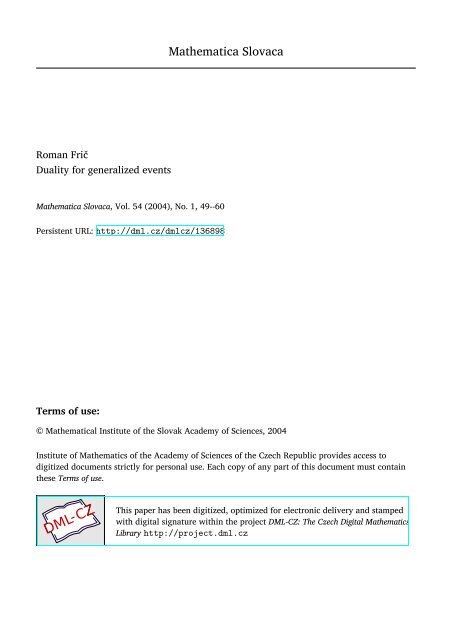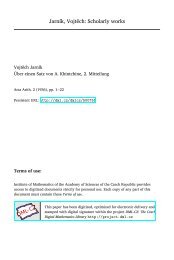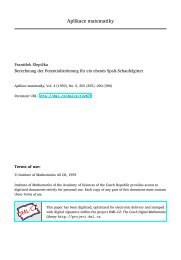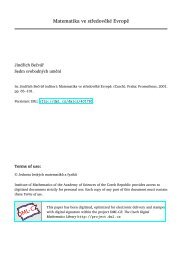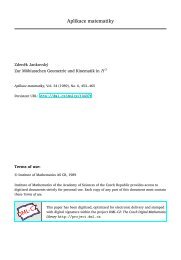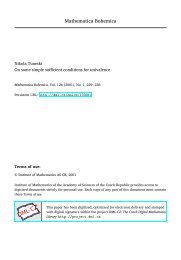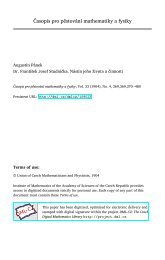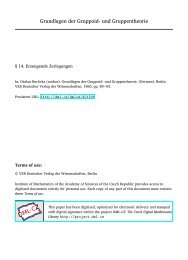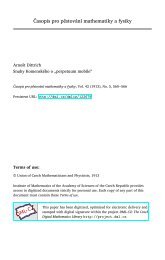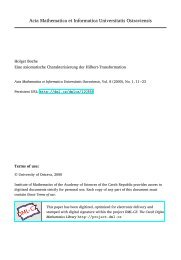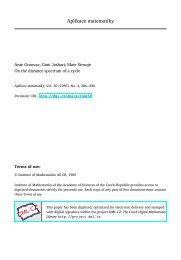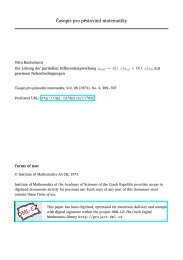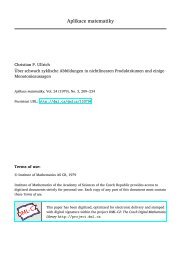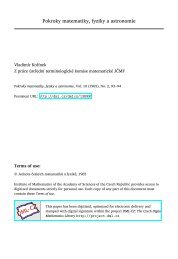Duality for generalized events
Duality for generalized events
Duality for generalized events
Create successful ePaper yourself
Turn your PDF publications into a flip-book with our unique Google optimized e-Paper software.
Roman Frič<br />
<strong>Duality</strong> <strong>for</strong> <strong>generalized</strong> <strong>events</strong><br />
Mathematica Slovaca, Vol. 54 (2004), No. 1, 49--60<br />
Persistent URL: http://dml.cz/dmlcz/136898<br />
Terms of use:<br />
Mathematica Slovaca<br />
© Mathematical Institute of the Slovak Academy of Sciences, 2004<br />
Institute of Mathematics of the Academy of Sciences of the Czech Republic provides access to<br />
digitized documents strictly <strong>for</strong> personal use. Each copy of any part of this document must contain<br />
these Terms of use.<br />
This paper has been digitized, optimized <strong>for</strong> electronic delivery and stamped<br />
with digital signature within the project DML-CZ: The Czech Digital Mathematics<br />
Library http://project.dml.cz
Mathematica<br />
Slovaca<br />
©2004<br />
.. , -., _. /rirk n A \ .. .. Ar , c ~ Mathematical Institute<br />
Math. SlOVaCa, 54 (2004), No. 1, 49-60 Slovák Academy of Sciences<br />
Dedicated to Professor Sylvia Pulmannovd<br />
on the occasion of her 65th birthday<br />
DUALITY FOR GENERALIZED EVENTS<br />
ROMAN FRIC<br />
(Communicated by Anatolij Dvurečenskij )<br />
ABSTRACT. We study the category of effect algebras (equivalently D-posets)<br />
carrying the initial sequential convergence with respect to a set of order determining<br />
probabilities. We define distinguished subcategories and describe their mutual<br />
relationships. In particular, we deal with duality, products, and coproducts. Such<br />
structures are suitable <strong>for</strong> modelling <strong>events</strong> having fuzzy and quantum nature.<br />
0. Introduction<br />
Undoubtedly ([3], [19], [4], [5], [6], [15], [29], [30], [16]), D-posets and effect<br />
algebras are suitable structures in the framework of which the <strong>generalized</strong> probability<br />
can be developed. We continue (cf. [7], [8], [9], [10], [11], [12], [13], [14])<br />
in our ef<strong>for</strong>t to study <strong>generalized</strong> probability using sequential convergence and<br />
categorical methods.<br />
Given a category, hom(X, Y) denotes the set of all morphisms from the object<br />
X into the object Y; it will be clear from the context which category hom(X, Y)<br />
refers to.<br />
2000 Mathematics Subject Classification: Primary 22A30, 54A20, 60A05; Secondary<br />
06A55, 08A72, 54C20.<br />
Keywords: D-poset, effect algebra, convergence D-poset, convergence effect algebra, order<br />
determining set of D-poset morphisms, I-convergence, sequentially continuous D-poset morphism,<br />
prob, probability, epireflection, cr-completion, absolute prob, sober prob, measurable<br />
space, measurable map, natural equivalence, duality, product, coproduct, operational random<br />
variable, <strong>generalized</strong>: event, random variable, observable.<br />
Supported by VEGA Grant 2/3163/23.<br />
49
ROMAN FRlC<br />
1. Convergence<br />
There is an extensive list of papers devoted to sequential convergence on<br />
various algebraic structures. Interesting results about sequential convergence on<br />
MF-algebras can be found in [17].<br />
By a sequential convergence on a set X we understand a subset L C X N x X<br />
satisfying the following conditions:<br />
(S) If (xn) is a constant sequence and xn = x, n G N, then ((xn),x) G L.<br />
(F) If ((xn),x) G L and (x'n) is a subsequence of (xn), then ((x'n),x) G L.<br />
In addition, we mention the following conditions:<br />
(H) If ((xn),x) G L and ((xn),y) G L, then x = y<br />
(the uniqueness of limits).<br />
(U) If (xn) is a sequence and x G X is a point such that <strong>for</strong> each subsequence<br />
(x'n) of (xn) there exists a subsequence (x'n) of (xn) such that<br />
((x'n),x) G L, then ((xn),x) G L (Frechet-Urysohn condition).<br />
(B) If ((an),x), ((bn),x) G L and an < xn < bn, n G N, then ((xn),x) G L.<br />
Let X = (\X\,
DUALITY FOR GENERALIZED EVENTS<br />
1.1. DEFINITION. Let X be an effect algebra and let L C X N x X be a<br />
sequential convergence on X such that<br />
(EC) If ((xn),x) G L, ((yn),y) G L and yn 0 xn exists <strong>for</strong> all n G N, then<br />
y 0 x exists and ((xn 0 yn), x 0 y) G L.<br />
Then X carrying L is said to be a convergence effect algebra.<br />
It is known (cf. [4; Theorem 1.3.4]) that the category of D-posets and<br />
K)-poset morphisms and the category of effect algebras and effect algebra morphisms<br />
are equivalent. The result can be <strong>generalized</strong> as follows.<br />
Denote CD the category whose objects are convergence F)-posets and whose<br />
morphisms are sequentially continuous D-poset morphisms. Denote CE the<br />
category whose objects are convergence effect algebras and whose morphisms<br />
are sequentially continuous effect algebra morphisms. Since each D-poset can<br />
be considered as a convergence D-poset carrying the trivial convergence (only<br />
constant sequences converge) and each D-poset morphism is sequentially continuous<br />
with respect to the trivial convergence, K)-posets (as trivial convergence<br />
D-posets) <strong>for</strong>m a full subcategory of CD. Similarly, effect algebras (as trivial<br />
convergence effect algebras) <strong>for</strong>m a full subcategory of CE .<br />
Let (X, CE and<br />
F2: CE —> CD , the compositions of which are the identity functors on CD<br />
and CE. Hence the two categories are isomorphic and isomorphic are also the<br />
subcategories consisting of objects carrying the trivial convergence.<br />
In what follows, J denotes the closed unit interval of real numbers carrying<br />
the usual algebraic (also the D-poset and the effect algebra) structures and the<br />
sequential convergence.<br />
1.2. OBSERVATION. The categories CD and CE are isomorphic.<br />
Now let us turn to the initial convergence with respect to sets of morphisms<br />
into I (in fact, probability measures). In view of the isomorphism between<br />
D-posets and effect algebras, in what follows we assume that the partial operations<br />
0 and 0 on a set X are dual, the partial order and the constants 0,<br />
1 are compatible with 0 and 0.<br />
51
ROMAN FRlC<br />
Let X be a D-poset. A subset H C hom(X, I) is said to be order determining<br />
(cf. [5]), or an ordering (cf. [4]), whenever h(b) < h(a) in I <strong>for</strong> all h G H<br />
implies b < a in X. Denote Ods(X) the set of all order determining subsets<br />
of hom(K,i~). Assume that hom(X,J) G Ods(K) (equivalently, Ods(X) ^ 0).<br />
For eaclr H G Ods(X) define the evaluation map evH: X —•> I H by evH(x) =<br />
(h(x)\ he H), x e X.Let \ evH(X)\ = {ev^(x) : x G X). The following is a<br />
folklore.<br />
1.3. LEMMA. evH(X) is a sub-D-poset of the power D-poset I H and X and<br />
evH(X) are isomorphic.<br />
Further, define LH C X N x X as follows: ((xn),x) G hH whenever <strong>for</strong> each<br />
h G H the sequence (h(xn)) converges in I to h(x).<br />
1.4. LEMMA. hH is a sequential convergence on X satisfying the axioms<br />
(DC), (EC), (H), (U), (B).<br />
Proof. If we identify X and evH(X), then hH becomes the pointwise<br />
convergence in I H restricted to evH(X). A straight<strong>for</strong>ward calculation shows<br />
that the axioms in question are satisfied. D<br />
For H,G G Ods(X), H C G implies LG C LH and \om(xj)<br />
ls the finest of<br />
all convergences hH, H G Ods(X). For H,G G Ods(X) define H ~ G whenever<br />
L^ = LG . It is an equivalence relation and each equivalence class [H] contains<br />
the maximal element H* — \J G. Denote hom^(X,/) = {h G hom(X, I) :<br />
Ge[H]<br />
h is sequentially continuous with respect to L^}. Then H* = hom//(X,I).<br />
Clearly, homhom(x/)(X,7) =hom(X,7).<br />
1.5. DEFINITION. Let X be a F>-poset and let H G Ods(X). Then LH is<br />
said to be an I-convergence. If H = hom(X, 7), then hH is said to be the fine<br />
convergence.<br />
Sub-D-posets of the power D-posets I H carrying the pointwise convergence,<br />
called jD(/)-posets, have been studied in [25]. In Section 3 we shall show that<br />
such D-posets and D-posets carrying /-convergences are naturally equivalent.<br />
Since D-posets and effect algebras are equivalent we propose a simple compromising<br />
terminology.<br />
The idea is similar as in topology where, in fact, we have four isomorphic<br />
structures defined via open sets, closed sets, a closure operator, neighborhoods.<br />
To define a topological space, we can start with any of the four (e.g. open sets)<br />
and then to define any of the remaining (e.g. neighborhoods of points), so that<br />
going back (defining an open set as a set containing a neighborhood of each of its<br />
points) we get the original one (open sets). Further, the morphisms defined via<br />
the preimages of the open or closed sets, via preserving the closure (if a point is<br />
52
DUALITY FOR GENERALIZED EVENTS<br />
in the closure of a set, then the image of the point is in the closure of the image of<br />
the set), or via the continuity at each point (using the neighbourhoods), yield the<br />
identical notion of a continuous map. And, instead of four different isomorphic<br />
categories (of open or closed sets spaces, closure spaces, neighborhood spaces),<br />
we work with topological spaces and continuous maps.<br />
1.6. DEFINITION. Let (X,
ROMAN FRlC<br />
sequential closedness. In this section we generalize such extension process to<br />
probs. The idea of the construction goes back to [23], [24].<br />
2.1. DEFINITION. Let E be a prob. If £ is a subprob of a prob E and<br />
each morphism from E into / can be extended to a morphism from E into I,<br />
then E is said to be I -embedded in E. Moreover, if each extension is uniquely<br />
determined, then E is said to be hom-dense in E. If E is sequentially closed in<br />
each prob in which it is /-embedded, then E is said to be absolutely sequentially<br />
closed, or simply absolute.<br />
Denote APB the full subcategory of PB consisting of all absolute probs.<br />
2.2. LEMMA. Let E be a prob. The following are equivalent:<br />
(i) E is absolute.<br />
(ii) In E the following implication holds true: if a sequence (xn) of elements<br />
of E does not converge in E, then there exists (p G hom(E: I) such that<br />
the sequence (p(xn)) does not converge in I.<br />
Proof.<br />
(i) implies (ii). Since E is a prob, the evaluation map ev is an isomorphism<br />
from E onto a subprob of / hom (^J). If we identify E with its image ev(E),<br />
then E becomes an /-embedded subprob of J hom (£>1). Assume (i) and let (xn)<br />
be a sequence in E which does not converge in E. Contrariwise, suppose that<br />
<strong>for</strong> each (p G hom(F7,1) the sequence (cp(xn)) converges in I. The sequence<br />
(ev(sn)) converges in J hom (£>1) and it follows from (i) that the limit belongs to<br />
ev(E). This is a contradiction.<br />
(ii) implies (i). Assume (ii). Contrariwise, suppose that (i) does not hold.<br />
Then E can be /-embedded in a prob E such that there exists a sequence (xn)<br />
of elements of E converging in £ to a point x G E\E. According to (ii) there<br />
exists (p G hom(j5, /) such that the sequence (
DUALITY FOR GENERALIZED EVENTS<br />
2.4. THEOREM. APB is an epireflective subcategory of PB .<br />
Proof. Let E be a prob. First, we shall construct a prob E such that:<br />
(el) There is no proper subprob F of E such that \E\ C |F| and |F| is<br />
sequentially closed in E;<br />
(e2) E is /-embedded in E\<br />
(e3) E is absolute.<br />
Second, we shall prove that the embedding of E into E is the desired epireflection:<br />
1. For each morphism cp from E into an absolute prob F there exists a<br />
unique morphism Tp from E into F such that the restriction of Tp to E<br />
is equal to (p, in symbols Tpj E = (p.<br />
2. The embedding of E into E is an epimorphism. Hence passing from E<br />
to E yields the desired epireflector.<br />
1. Consider the evaluation mapping ev from E into J hom (£J) defined by<br />
ev(x) = ((#);
ROMAN FRlC<br />
Denote a the epireflector from PB onto APB assigning to a prob E the<br />
prob E = a(E) and to each morphism -0 from a prob E into a prob F the<br />
unique morphism a(ip) from a(E) into a(F) defined as follows: let ip be the<br />
composition of ip and the embedding map from F into a(F), let Tp be the<br />
unique extension of 3^, defined by f < (u) = u o / is a sequentially continuous<br />
D-poset morphism. Denote MH? the category of ID-measurable spaces and<br />
ID -measurable maps. Denote SMID its subcategory consisting of sober spaces.<br />
56
DUALITY FOR GENERALIZED EVENTS<br />
If (X, X) is a sober space, then <strong>for</strong> each sequentially continuous D-poset morphism<br />
h of X into y there exists an (X, y) -measurable map / such that<br />
h = f«. This is the essence of the duality between ID and SMID ([25; Theorem<br />
1.12]).<br />
The duality can be extended to probs. Indeed, the duality means that there<br />
exist a natural equivalence functor F: PB -» SMID op , where the target category<br />
SMID op is the opposite category associated to SMID (the same objects<br />
but the direction of the arrows is reversed). It is known that SID and SMID op<br />
are isomorphic ([25; Theorem 1.11]). Hence to show that PB and SMID are<br />
dual, it suffices to construct a natural equivalence functor G: PB -» SID .<br />
Let X be a D-poset admitting an order determining set H £ hom(X, 7),<br />
let hH be the corresponding /-convergence, and let H* = hom//(X,I). Consider<br />
the resulting prob (X, SID , the functor is full and<br />
faithful, and each object of SID is isomorphic to the evaluation of some prob<br />
(cf. [20; Theorem IV.4.1]). But this is obvious.<br />
COROLLARY 3.1. The categories PB and SMID are dual.<br />
Further, reorganizing each ID -object X C I x into a prob, we get the category<br />
MPB of PB -measurable spaces and its subcategory SMPB of sober<br />
objects.<br />
COROLLARY 3.2. The categories PB and SMPB are dual.<br />
An ID-measurable space (X,X) is said to be closed if X is sequentially<br />
closed in I x . The subcategory CMID of MID consisting of closed<br />
ID-measurable spaces is monocoreflective in MID (cf. [25]). Accordingly, we<br />
say that a prob X and the PB -measurable space (X, X) are closed whenever<br />
X as an ID -object is closed. It follows that the subcategory CMPB of<br />
closed PB -measurable spaces is monocoreflective in the category MPB . For a<br />
PB -measurable space (X, X) denote (X, cr(X)) the monocoreflection. If (X, X)<br />
is sober, then (X, cr(X)) is sober, too.<br />
COROLLARY 3.3. The duality between PB and SMPB commutes with the<br />
epireflector sending a prob X to the absolute prob O~(X) and the monocoreflector<br />
sending the sober PB -measurable space (H, %), where H = hom(X, I) and<br />
T-L is the image of X under the evaluation map (via H), to the closed sober<br />
PB-measurable space (il, O-('H)). If X is absolute, then % is closed.<br />
Observe that a 2-chain {0, a, 1} admits an order determining family, but<br />
the diamond {0, a, b, 1} as the coproduct in the category of D-posets of two<br />
57
ROMAN FRICZ<br />
2-chains does not admit any order determining family. M. Papco, at the<br />
SCAM-conference in Bratislava, April 2003 (cf. [25]), presented the construction<br />
of the product of ID -measurable spaces leading to the construction of the<br />
coproduct in the category ID . The latter yields the coproduct in the category<br />
PB.<br />
Let {Xs : s G 5} be a family of probs. Denote Hs = hom(X3,I) and,<br />
as a rule, identify Xs and its image evs(X3) C I Hs under the evaluation map<br />
evs: Xs -> I H *. Consider the product H = Y\ Hs and the prob I H . For t G S,<br />
s£S<br />
define a natural embedding nt of evt(Xt) = Xt into I H , sending u G Xt C I Ht<br />
to ut G I H defined as follows: <strong>for</strong> h = (h3; s G S) G H put ut(h) = u(ht), i.e.<br />
i/t depends only on the tth coordinate. It is a sequentially continuous D-poset<br />
morphism of Xt into I H . Let X C I H he the minimal subprob of I H which<br />
contains KS(XS), S G 5. If all involved probs are considered as ID objects<br />
and all PB morphisms are considered as ID morphisms, then (as shown by<br />
M. Papco) X, together with the coprojections {KS : Xs -» X : s G S}, is the<br />
coproduct of the family {Xs : s G 5} in ID .<br />
THEOREM 3.4. Let {Xs : s G S} be a family of probs. Then X, together<br />
with the coprojections {KS : Xs —> X : s G 5}, is the coproduct of the family<br />
{Xs: se S} in PB .<br />
Proof. The assertion follows directly from the definition of a coprodut and<br />
the fact that each prob and its image under the evaluation (via the set of all<br />
morphisms) are isomorphic. •<br />
4. Remarks<br />
The categories PB and MPB provide a tool <strong>for</strong> studying <strong>generalized</strong> probability:<br />
<strong>events</strong>, measures, random variables, observables. In [1], [2] (see also [15])<br />
the operational random variable is defined as a suitable map of the set of all probability<br />
measures on one measurable space into the set of all probability measures<br />
on another measurable space. If the map sends a point measure (an elementary<br />
event) to a nontrivial probability measure, then the random variable has a quantum<br />
nature. We claim that ID -measurable maps, and hence PB -measurable<br />
maps, generalize the operational random variables. Further, the duality between<br />
PB and SMPB covers the duality between operational random variables and<br />
the observables (going the opposite direction) as it is described in [1], [2]. We<br />
also claim that the sequential convergence and the categorical approach shed<br />
more light on the duality between the operational random variables and the<br />
observables.<br />
58
DUALITY FOR GENERALIZED EVENTS<br />
As already stated in [25], in order to develop further probability notions,<br />
it might be useful to introduce and study on D-posets and hence on probs a<br />
multiplication operation (cf. [21], [22], [18], [27], [28]).<br />
REFERENCES<br />
BUGAJSKI, S.: Statistical maps I. Basic properties, Math. Slovaca 51 (2001), 321-342.<br />
BUGAJSKI, S.: Statistical maps II. Operational random variables, Math. Slovaca 51<br />
(2001), 343-361.<br />
CHOVANEC, F.—KÔPKA, F.: Difference posets in the quantum structures background,<br />
Internat. J. Theoret. Phys. 39 (2000), 571-583.<br />
DVUREČENSKIJ, A.—PULMANNOVÁ, S.: New Trends in Quantum Structures,<br />
Kluwer Academic Publ./Ister Science, Dordrecht/Bratislava, 2000.<br />
FOULIS, D. J.: Algebraic measure theory, Atti. Sem. Mat. Fis. Univ. Modena 48 (2000),<br />
435-461.<br />
FOULIS, D. J.—BENNETT, M. K.: Effect algebras and unsharp quantum logics, Found.<br />
Phys. 24 (1994), 1331-1352.<br />
FRIC, R.: Sequential structures and probability: categorical reflections. In: Mathematik-Arbeitspapiere<br />
48 (H.-E. Porst, ed.), Universität Bremen, 1997, pp. 157-169.<br />
FRIC, R.: A Stone type duality and its applications to probability, Topology Proc. 22<br />
(1999), 125-137.<br />
FRIČ, R.: On observables, Internat. J. Theoret. Phys. 39 (2000), 677-686.<br />
FRIČ, R.: MV-Algebras: convergence and duality. In: Mathematik-Arbeitspapiere 54<br />
(H. Herrlich, H.-E. Porst, eds.), Universität Bremen, 2000, pp. 169-179.<br />
FRIČ, R.: Convergence and duality, Appl. Categ. Structures. 10 (2002), 257-266.<br />
FRIČ, R.: Measures on MV-algebras, Soft Comput. 7 (2002), 130-137.<br />
FRIC, R.: Łukasiewicz tribes are absolutely sequentially closed bold algebras, Czechoslovak<br />
Math. J. 52 (2002), 861-874.<br />
FRIC, R.—JAKUBÍK, J.: Sequential convergences on Boolean algebras defined by systems<br />
of maximal filters, Czechoslovak Math. J. 51 (2001), 261-274.<br />
GUDDER, S.: Combinations of observables, Internat. J. Theoret. Phys. 31 (2000),<br />
695-704.<br />
JENČA, G.: Blocks of homogeneous effect algebras, Bull. Austral. Math. Soc. 64 (2001),<br />
81-98.<br />
JAKUBÍK, J.: Sequential convergence in MV-algebras, Czechoslovak. Math. J. 45,<br />
(1995), 709-726.<br />
JUREČKOVÁ, M.: On the conditional expectation on probability MV-algebras with product,<br />
Soft Comput. 5 (2001), 381-385..<br />
KÔPKA, F.—CHOVANEC, F.: D-posets, Math. Slovaca 44 (1994), 21-34.<br />
MAC LANE, S.: Categories <strong>for</strong> the Working Mathematician, Springer-Verlag, New<br />
York-Heildelberg-Berlin, 1988.<br />
MUNDICI, D.: Tensor products and the Loomis-Sikorski theorem <strong>for</strong> MV-algebras, Adv.<br />
in Appl. Math. 22 (1999), 227-248.<br />
MUNDICI, D.—RIEČAN, B.: Probability on MV-algebras. In: Handbook of Measure<br />
Theory (E. Pap, ed.), North-Holland, Amsterdam, 2002.<br />
59
ROMAN FRl£<br />
[23] NOVAK, J. : Uber die eindeutigen stetigen Erweiterungen stetiger Funktionen, Czechoslovak<br />
Math. J. 8 (1958), 344-355.<br />
[24] NOVAK, J.: On sequential envelopes defined by means of certain classes of functions,<br />
Czechoslovak Math. J. 18 (1968), 450-456.<br />
[25] PAPCO, M.: On measurable spaces and measurable maps, Tatra Mt. Math. Publ.<br />
(To appear).<br />
[26] PAPCO, M.: On effect algebras. Preprint, 2003.<br />
[27] PETROVICOVA, J.: On the entropy of partitions in product MV-algebras, Soft Comput.<br />
4 (2000), 41-44.<br />
[28] PETROVICOVA, J.: On the entropy of dynamical systems in product MV-algebras,<br />
Fuzzy Sets and Systems 121 (2001), 347-351.<br />
[29] RIECAN, B.—NEUBRUNN, T.: Integral, Measure, and Ordering, Kluwer Acad. PubL,<br />
Dordrecht-Boston-London, 1997.<br />
[30] RIECANOVA, Z.: Proper effect algebras admitting no states, Internat. J. Theoret. Phys.<br />
40 (2001), 1683-1691.<br />
Received Apríl 11, 2003 Mathematical Institute<br />
Slovák Academy of Sciences<br />
Grešákova 6<br />
SK-040 01 Košice<br />
SLOVAKIA<br />
60<br />
E-mail: fric@saske.sk


